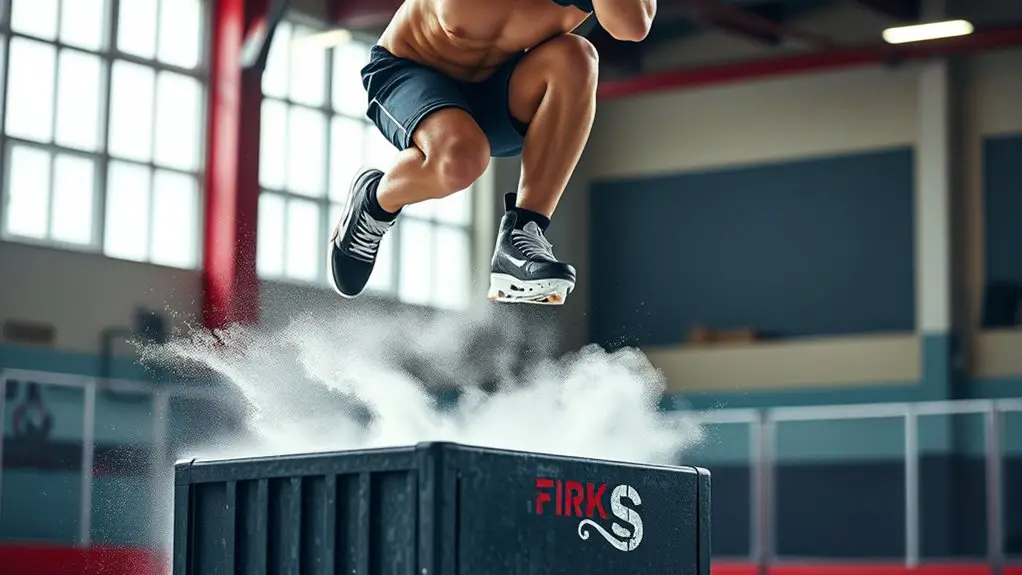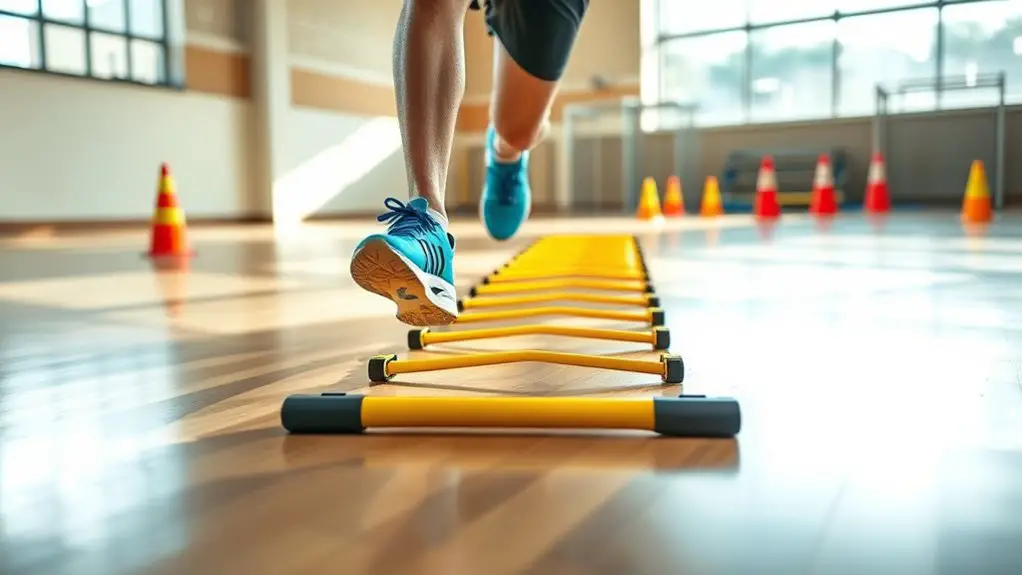To boost your explosiveness on the ice, you should incorporate plyometric exercises like box jumps, lateral bounds, depth jumps, medicine ball slams, and plyometric push-ups into your routine. Focus on proper techniques to maximize your power, engage your core, and land softly to prevent injury. These exercises enhance your strength, speed, and coordination, making a significant impact on your performance. If you're looking for more training tips and variations, there's plenty more to uncover.
Box Jumps
Box jumps are a fantastic plyometric exercise that can greatly enhance your hockey performance. They develop explosive strength, which is essential for those quick starts and powerful strides on the ice. To get the most out of box jumps, focus on proper box jump techniques. Start by choosing a box height that challenges you without compromising your form. As you jump, make sure you land softly, absorbing the impact with your knees slightly bent.
To keep things fresh and avoid a workout rut, try box jump variations. You can mix in lateral box jumps for added agility or single-leg jumps to target stability and balance. Incorporating these variations helps you build the strength and explosiveness needed for hockey, giving you that edge over your competition. Additionally, box jumps enhance neuromuscular control, which translates to improved coordination and fluid movement on the ice. So, embrace the freedom of movement, and let those box jumps elevate your game to new heights!
Lateral Bounds
Lateral Bounds
Lateral bounds are an excellent plyometric exercise that can greatly improve your lateral movement on the ice. This move enhances your explosive strength, allowing you to dart quickly in both directions. By incorporating lateral bounds into your training, you'll develop the agility and power you need to outmaneuver opponents. Additionally, these exercises engage fast-twitch muscle fibers, which are essential for increasing speed.
Here's a quick guide to help you master lateral bounds:
| Step | Description | Tips |
|---|---|---|
| Setup | Stand on one leg, other leg bent. | Keep your core tight. |
| Jump | Push off from your standing leg. | Focus on height and distance. |
| Land | Land softly on the opposite leg. | Absorb the impact gently. |
| Repeat | Switch legs and repeat the process. | Maintain a steady rhythm. |
Try adding these to your routine, and you'll feel the difference in your game!
Depth Jumps
Depth jumps are a powerful plyometric exercise that can enhance your explosiveness and reactive strength on the ice. To perform this exercise, start by standing on a sturdy platform, usually about 12-24 inches high. Step off the platform, focusing on your jump technique as you hit the ground. Aim to land softly while maintaining good posture; your landing mechanics are vital for injury prevention and maximizing power.
As you hit the ground, immediately jump as high as you can. This reactive movement trains your muscles to respond quickly and efficiently, which is essential in hockey. Start with a few sets of 5-8 reps, allowing adequate rest between sets. As you get comfortable, increase the height of the platform or the intensity of your jumps. Mastering depth jumps will give you that explosive edge, helping you break free on the ice and elevate your game. Additionally, incorporating proper technique is crucial for maximizing explosive power and reducing injury risk.
Medicine Ball Slams
Building on the explosive power developed through depth jumps, medicine ball slams are another effective plyometric exercise that can boost your strength and speed on the ice. To get the most out of this dynamic move, focus on your technique. Start by standing with your feet shoulder-width apart, holding the medicine ball overhead. As you slam the ball down, engage your core and use your legs to drive the movement, ensuring you follow through. This not only enhances explosiveness but also helps with injury prevention by strengthening your shoulders and core. Incorporating core strengthening exercises into your routine can further improve your overall athletic performance.
Remember to keep your back straight and avoid rounding your spine during the slam. Incorporate this exercise into your training routine, aiming for three sets of 8-12 reps. With consistent practice and proper technique, you'll feel the benefits on the ice, giving you that extra edge in your game. Embrace the freedom this exercise offers in building your athleticism!
Plyometric Push-Ups
Plyometric push-ups are a fantastic way to enhance your upper body strength and explosive power for hockey. This dynamic exercise gives you the freedom to push your limits while building muscle in your chest, shoulders, and triceps. To perform a plyometric push-up, get into a standard push-up position, lower yourself, and then explode upward, allowing your hands to leave the ground briefly. This push-up variation not only boosts your explosive strength but also engages your core, essential for maintaining stability on the ice. Incorporating plyometric training into your routine can significantly enhance your overall athletic performance.
You can mix things up by incorporating different push-up variations, like clapping push-ups or using a bench for added challenge. As you progress, you'll notice an improvement in your overall performance, making you quicker and more agile during games. So, embrace the challenge of plyometric push-ups and watch your game elevate to new heights!
Frequently Asked Questions
How Often Should I Incorporate Plyometrics Into My Training Routine?
When deciding how often to incorporate plyometrics into your training schedule, aim for two to three sessions per week. This frequency allows your body to recover while still benefiting from explosive movements. Make sure to listen to your body and adjust as needed—freedom in your routine is key! Integrating plyometrics consistently will help enhance your performance, but it's important not to overdo it to avoid injury. Balance is everything!
What Is the Ideal Warm-Up Before Plyometric Exercises?
Before diving into plyometric exercises, you'll want to warm up effectively. Start with dynamic stretches to get your muscles ready; think leg swings and arm circles. Then, move into mobility drills to enhance your range of motion. These drills don't just prepare your body; they also help prevent injuries, allowing you the freedom to train harder and longer without setbacks. Embrace this warm-up routine, and you'll be primed for explosive performance!
Can Beginners Perform Plyometric Exercises Safely?
Absolutely, beginners can perform plyometric exercises safely, but you should prioritize safety first. Start with lower-impact variations to ease into the movements, and don't hesitate to use exercise modifications as needed. Focus on proper form and control to avoid injury. It's all about listening to your body and progressing at your own pace. With patience and the right approach, you can enjoy the freedom and benefits of plyometrics without unnecessary risks.
Are There Any Risks Associated With Plyometric Training?
While plyometric training can be a thrilling adventure for your body, it comes with its own set of challenges. You might face risks like strains or sprains if you're not careful. To embrace the freedom of movement, you'll want to focus on injury prevention through proper technique and progression. If you respect your limits, you'll enjoy the training adaptations that come with it, enhancing your performance while minimizing potential setbacks.
How Can I Track My Progress in Plyometric Exercises?
Tracking your progress in plyometric exercises is essential for improvement. You can use various progress metrics like jump height, number of repetitions, and time taken for specific drills. Consider keeping a workout journal or using apps designed for tracking methods to log your performance regularly. This way, you'll notice patterns and adjust your training accordingly, ensuring you stay on your path to freedom in achieving your fitness goals.




